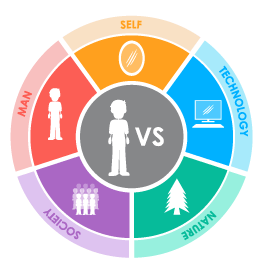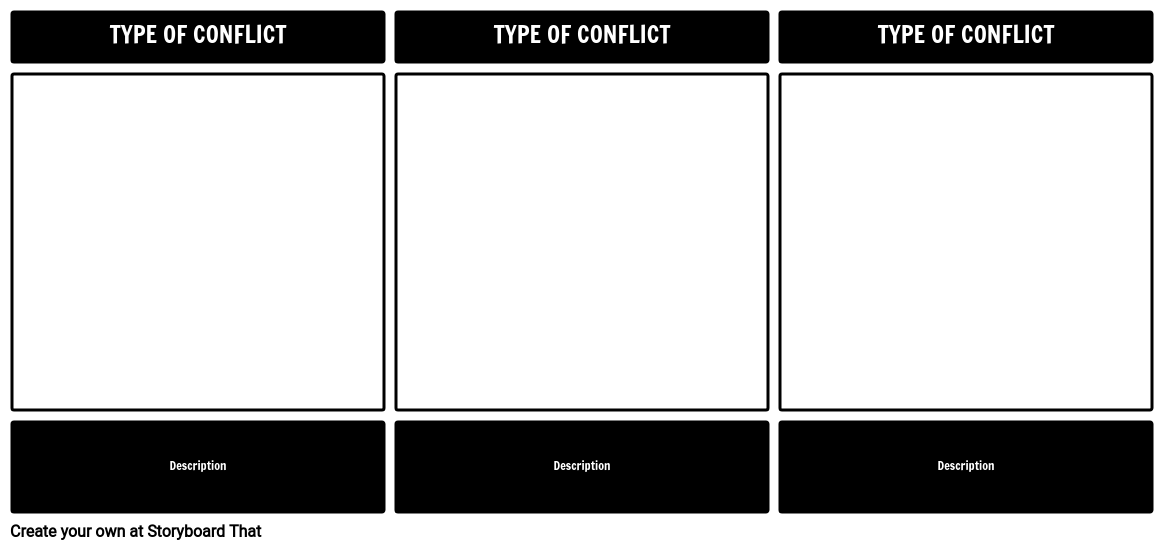Lesson Plan Overview
Storyboarding is an excellent way to focus on types of literary conflict. Have your students choose an example of each literary conflict and depict them using the Storyboard Creator. In the storyboard, an example of each conflict should be visually represented, along with an explanation of the scene, and how it fits the particular category of conflict.
Literary Conflict in A Thousand Splendid Suns
MAN vs. MAN
After Tariq hears that neighborhood bully Khadim had sprayed Laila with urine from a water gun to mock her “yellow hair”, he attacks Khadim with his prosthetic leg. After the fight, Khadim never bothers Laila again.
MAN vs. SELF
Laila wakes up after her parents are killed by a rocket that hit their house, finding that she has been saved and taken care of by Rasheed. She also knows that she is pregnant with Tariq’s child, and that as an unwed mother, she will be in danger. Despite Mariam’s objections and obvious anger at the threat she feels Laila poses, Laila agrees to marry Rasheed to protect herself and her baby.
MAN vs. SOCIETY
Laila and Mariam try to escape on a bus to Peshawar with Aziza. However, they cannot board the bus without a male family member, so they enlist the help of someone they deem to be a friendly man. He turns them in to the authorities, who send them back to Rasheed. It is a crime for a woman to run away from her husband, according to the Taliban.
Template and Class Instructions
(These instructions are completely customizable. After clicking "Copy Activity", update the instructions on the Edit Tab of the assignment.)
Student Instructions
Create a storyboard that shows at least three forms of literary conflict in A Thousand Splendid Suns.
- Identify conflicts in A Thousand Splendid Suns.
- Categorize each conflict as Character vs. Character, Character vs. Self, Character vs. Society, Character vs. Nature, or Character vs. Technology.
- Illustrate conflicts in the cells, using characters from the story.
- Write a short description of the conflict below the cell.
Lesson Plan Reference
Student Rubric
(You can also create your own on Quick Rubric.)
| Proficient | Emerging | Beginning | Try Again | |
|---|---|---|---|---|
| Conflict Identification | Student identifies correct major conflicts and uses strong, clear textual evidence to support choice. | Student identifies correct major conflict and uses few or unclear details to support their choice. | Student identifies incorrect major conflict, and uses some details from the text to support their choice. | Student does not attempt to identify major conflict or identifies incorrect major conflict with no explanation. |
| Understanding Outcome | Student clearly shows the outcome of the conflict and its effects on the protagonist with evidence from the text. | Student shows the outcome of the conflict and its effect on the protagonist, but some evidence is unclear. | Student shows the outcome of the conflict, but does not examine its effect on the protagonist and uses some vague textual evidence. | Student does not clearly show the outcome of the conflict or use textual evidence. |
| Character | Storyboard includes all required characters and clearly names them. Goes above and beyond by adding additional details. | Storyboard includes all required characters and clearly names them. | Storyboard includes protagonist and antagonist but leaves out other required characters. | Storyboard does not include the names of required characters. |
| Storyboard | Student clearly shows effort to convey the setting the scene of the book | Student attempts to convey setting and scene of the book, but lacks some clarity. | Student does not clearly convey the setting and scene. | Student makes little or no attempt to convey the setting or scene. |
| Spelling and Grammar | Student uses exemplary spelling and grammar. There are no errors. | Student makes a minor error in spelling and grammar. | Student makes several minor errors in spelling and grammar. | Student makes many errors in spelling and grammar; little attempt at spellchecking. |
Lesson Plan Overview
Storyboarding is an excellent way to focus on types of literary conflict. Have your students choose an example of each literary conflict and depict them using the Storyboard Creator. In the storyboard, an example of each conflict should be visually represented, along with an explanation of the scene, and how it fits the particular category of conflict.
Literary Conflict in A Thousand Splendid Suns
MAN vs. MAN
After Tariq hears that neighborhood bully Khadim had sprayed Laila with urine from a water gun to mock her “yellow hair”, he attacks Khadim with his prosthetic leg. After the fight, Khadim never bothers Laila again.
MAN vs. SELF
Laila wakes up after her parents are killed by a rocket that hit their house, finding that she has been saved and taken care of by Rasheed. She also knows that she is pregnant with Tariq’s child, and that as an unwed mother, she will be in danger. Despite Mariam’s objections and obvious anger at the threat she feels Laila poses, Laila agrees to marry Rasheed to protect herself and her baby.
MAN vs. SOCIETY
Laila and Mariam try to escape on a bus to Peshawar with Aziza. However, they cannot board the bus without a male family member, so they enlist the help of someone they deem to be a friendly man. He turns them in to the authorities, who send them back to Rasheed. It is a crime for a woman to run away from her husband, according to the Taliban.
Template and Class Instructions
(These instructions are completely customizable. After clicking "Copy Activity", update the instructions on the Edit Tab of the assignment.)
Student Instructions
Create a storyboard that shows at least three forms of literary conflict in A Thousand Splendid Suns.
- Identify conflicts in A Thousand Splendid Suns.
- Categorize each conflict as Character vs. Character, Character vs. Self, Character vs. Society, Character vs. Nature, or Character vs. Technology.
- Illustrate conflicts in the cells, using characters from the story.
- Write a short description of the conflict below the cell.
Lesson Plan Reference
Student Rubric
(You can also create your own on Quick Rubric.)
| Proficient | Emerging | Beginning | Try Again | |
|---|---|---|---|---|
| Conflict Identification | Student identifies correct major conflicts and uses strong, clear textual evidence to support choice. | Student identifies correct major conflict and uses few or unclear details to support their choice. | Student identifies incorrect major conflict, and uses some details from the text to support their choice. | Student does not attempt to identify major conflict or identifies incorrect major conflict with no explanation. |
| Understanding Outcome | Student clearly shows the outcome of the conflict and its effects on the protagonist with evidence from the text. | Student shows the outcome of the conflict and its effect on the protagonist, but some evidence is unclear. | Student shows the outcome of the conflict, but does not examine its effect on the protagonist and uses some vague textual evidence. | Student does not clearly show the outcome of the conflict or use textual evidence. |
| Character | Storyboard includes all required characters and clearly names them. Goes above and beyond by adding additional details. | Storyboard includes all required characters and clearly names them. | Storyboard includes protagonist and antagonist but leaves out other required characters. | Storyboard does not include the names of required characters. |
| Storyboard | Student clearly shows effort to convey the setting the scene of the book | Student attempts to convey setting and scene of the book, but lacks some clarity. | Student does not clearly convey the setting and scene. | Student makes little or no attempt to convey the setting or scene. |
| Spelling and Grammar | Student uses exemplary spelling and grammar. There are no errors. | Student makes a minor error in spelling and grammar. | Student makes several minor errors in spelling and grammar. | Student makes many errors in spelling and grammar; little attempt at spellchecking. |
How Tos about Literary Conflict in A Thousand Splendid Suns
Set clear objectives for teaching literary conflict
Begin by outlining what you want students to learn about literary conflict. Clear objectives help students focus and understand why these concepts matter in stories like A Thousand Splendid Suns.
Introduce conflict types with relatable examples
Use simple, real-life scenarios or stories your students know to explain each conflict type. Relatable examples make abstract ideas more concrete and memorable for grades 2–8.
Guide students to identify conflicts in class texts
Model how to spot different conflicts in the book you’re reading together. Think aloud as you work, then have students try it with a partner or small group.
Create a collaborative class conflict chart
Draw a chart on the board or use poster paper to track examples of each conflict type from your current readings. Invite students to add to it as they find new examples, building ownership and deepening understanding.
Assign creative projects to reinforce understanding
Have students create their own storyboards, comic strips, or digital slideshows showing each conflict type. Creative projects let students demonstrate learning in a fun, hands-on way.
Frequently Asked Questions about Literary Conflict in A Thousand Splendid Suns
What are the main types of literary conflict in A Thousand Splendid Suns?
A Thousand Splendid Suns features several types of literary conflict: Man vs. Man (characters in direct opposition), Man vs. Self (internal struggles), and Man vs. Society (characters against societal norms or laws). These conflicts drive the plot and reveal the characters' growth and challenges.
How can I teach literary conflict using A Thousand Splendid Suns?
Use storyboarding to help students identify and illustrate different conflicts. Have students select scenes showing character vs. character, character vs. self, and character vs. society, then create storyboards with images and brief explanations for each conflict type.
What is an example of Man vs. Man conflict in A Thousand Splendid Suns?
A key Man vs. Man conflict occurs when Tariq defends Laila by fighting Khadim, the neighborhood bully. This scene highlights personal bravery and the protective relationships between characters.
Why is it important for students to identify types of conflict in literature?
Recognizing different literary conflicts helps students understand character motivations, plot development, and the underlying themes of a story. It encourages critical thinking and deeper literary analysis.
What is the best way to visually represent literary conflict in the classroom?
The Storyboard Creator is an effective tool for visually representing conflicts. Students can illustrate scenes, label conflict types, and write short descriptions, making abstract concepts more concrete and engaging.
More Storyboard That Activities
A Thousand Splendid Suns
- Australia - South Australia - Police (black)(full badge) • conner395 • License Attribution (http://creativecommons.org/licenses/by/2.0/)
Testimonials

“By using the product, they were so excited and they learned so much...”–K-5 Librarian and Instructinal Technology Teacher

“I'm doing a Napoleon timeline and I'm having [students] determine whether or not Napoleon was a good guy or a bad guy or somewhere in between.”–History and Special Ed Teacher

“Students get to be creative with Storyboard That and there's so many visuals for them to pick from... It makes it really accessible for all students in the class.”–Third Grade Teacher
© 2026 - Clever Prototypes, LLC - All rights reserved.
StoryboardThat is a trademark of Clever Prototypes, LLC, and Registered in U.S. Patent and Trademark Office








